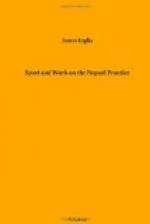The putwarrie, then, is an important personage. He has his cutcherry, or office, where he and his tribe (for there are always numbers of his fellow caste men who help him in his books and accounts) squat on their mat on the ground. Each possesses the instruments of his calling in the shape of a small brass ink-pot, and an oblong box containing a knife, pencil, and several reeds for pens. Each has a bundle of papers and documents before him, this is called his busta, and contains all the papers he uses. There they sit, and have fierce squabbles with the tenantry. There is always some noise about a putwarrie’s cutcherry. He has generally some half dozen quarrels on hand, but he trusts to his pen, and tongue, and clever brain. He is essentially a man of peace, hating physical contests, delighting in a keen argument, and an encounter with a plotting, calculating brain. Another proverb says that the putwarrie has as much chance of becoming a soldier as a sheep has of success in attacking a wolf.
The lohar, or blacksmith, is very unlike his prototype at home. Here is no sounding anvil, no dusky shop, with the sparks from the heated iron lighting up its dim recesses. There is little to remind one of Longfellow’s beautiful poem. The lohar sits in the open air. His hammers and other implements of trade are very primitive. Like all native handicraftsmen he sits down at his work. His bellows are made of two loose bags of sheepskin, lifted alternately by the attendant coolie. As they lift they get inflated with air; they are then sharply forced down on their own folds, and the contained air ejected forcibly through an iron or clay nozzle, into the very small heap of glowing charcoal which forms the fire. His principal work is making and sharpening the uncouth-looking ploughshares, which look more like flat blunt chisels than anything else. They also make and keep in repair the hussowahs, or serrated sickles, with which the crops are cut. They are slow at their task, but many of them are ingenious workers in metal. They are very imitative, and I have seen many English tools and even gun-locks, made by a common native village blacksmith, that could not be surpassed in delicacy of finish by any English smith. It is foreign to our ideas of the brawny blacksmith, to hear that he sits to his work, but this is the invariable custom. Even carpenters and masons squat down to theirs. Cheap labour is but an arbitrary term, and a country smith at home might do the work of ten or twelve men in India; but it is just as well to get an idea of existing differences. On many of the factories there are very intelligent mistrees, which is the term for the master blacksmith. These men, getting but twenty-four to thirty shillings a month, and supplying themselves with food and clothing, are nevertheless competent to work all the machinery, attend to the engine, and do all the ironwork necessary for the factory. They will superintend the staff of blacksmiths; and if the sewing-machine of the mem sahib, the gun-lock of the luna sahib, the lawn-mower, English pump, or other machine gets out of order, requiring any metal work, the mistree is called in, and is generally competent to put things to rights.




